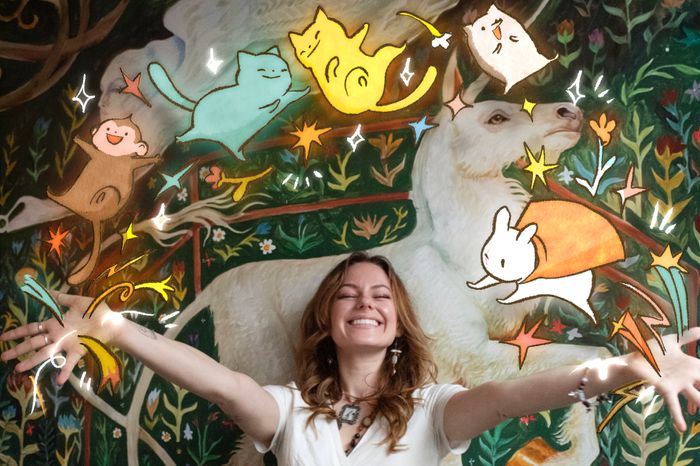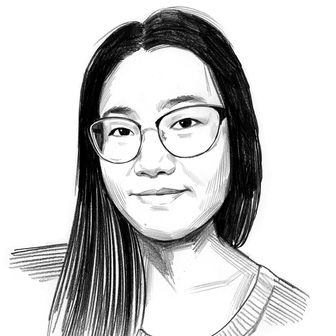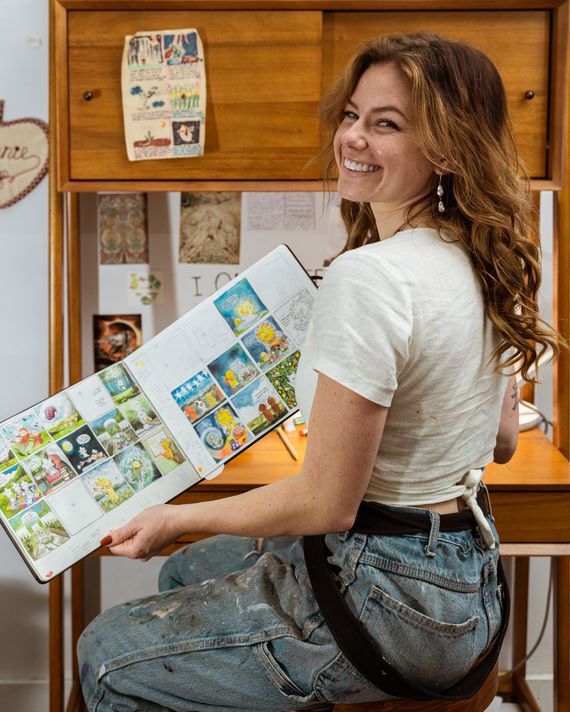
Scrolling through her page, it’s hard to imagine that Anna-Laura Sullivan spent most of her life making black-and-white art. Today, the Brooklyn-based artist is known for the vibrant comics that she posts to more than half a million followers, including Gigi Hadid, on Instagram (@annalaura_art). The 26-year-old intentionally designed her corner of the internet to feel slower and softer, from her use of watercolors (“a deliberate denial of the fast-paced sleekness of the modern world we’re living in”) to the overall children’s-book aesthetic of the world that her earnest little animal characters inhabit. “More words and more complexity just kind of infuses my own ego into it,” she says. “I’m not trying to teach, I’m just trying to give you a gentle nudge toward what you already know.” Compassion, self-understanding, and the ability to find beauty even in moments of suffering — she believes we’re born with all of it.
Sullivan’s work has been reposted by celebrities from Lil Nas X to Daniel Kwan, and she sells prints and merch in a newly launched online shop. She’s got a middle-grade graphic novel “in the works” and is currently pitching children’s books that will feature some familiar critters. Yet she still also sets aside time to read her DMs and comments, which she says she’s never been able to do without crying. Naturally, she has also shed “tears of gratitude” while creating her art. “I feel like I’m so emotional,” Sullivan says, laughing. “But I love it, I think it’s my superpower. I wouldn’t trade it for anything.”
Your work feels so nostalgic. Could you tell me a bit about what your childhood was like? I read that you spent some time growing up in a Nebraska cornfield.
My dad was in the military, so we moved around a lot. I was the new kid almost every year, and I think that really informed my sense of observation and openness. This was kind of the very last era before social media, before phones became so prevalent. It radically impacted my life that I had so much space to be a kid. I spent almost all of my time in nature, and I just was engaging in that conversation of imagination and nature all the time. It really made silence feel like a home. I just think the pace of my childhood was a lot slower, and I’m grateful for it.
As someone who makes such hopeful and warm art, what is your relationship with despair?
Great question. In college and high school, I had a lot of sadness. I wanted to be taken seriously as an artist, and I remember making very dark paintings. I was trying to wail and moan my experience out through my work. It wasn’t until I reached a true depth of sadness where I came to the understanding that there’s such profundity in joy. If you genuinely feel gratitude and the beauty that’s around you, you can overcome any bleakness. It’s not a weakness to embrace joy — it’s actually one of the most vital and powerful things you can do.
How do you come up with ideas for these comics?
I carry a journal with me everywhere. Whenever there’s a moment where I’m just like, I never want to forget this, this is what it’s all about, I write it down. I can look at every comic and remember the couch we were sitting on, or what that laugh sounded like, or what that cry felt like. I couldn’t be the artist I am without the people who’ve loved me and who love me now. It’s all coming from a deeply real place.
The true task of my work is trying to find a way to take that invisible world and make a tiny window through it. I’ve found that this art style in particular is a great window because the characters can be anyone. They’re universal. I think they’re perfect vessels for what a soul is: a very soft, gentle thing. And because the characters have no shape, gender, age, race, anything, they can be everything all at once. One of the most fascinating outcomes of these projects is people apply all different types of love connections to these characters. They can be your best friend, they can be your lover … it just shows the magnitude of what love is.
Is there an aspect of the creative process that you struggle with, or that takes longer?
With these comics in particular, I feel so grateful to say that they’re really just pouring out of me. I don’t know how long I’ll be possessed with this ghost of inspiration. Maybe the most difficult part is relinquishing control of how the comics are received. Making a work of art is kind of like having a baby. And then they go to college, and then you’ll see them on Pinterest without a watermark. [Laughs.]
Well, they have been received really well on the internet. Gigi Hadid follows you, and —
Does she really?
She does!
What? That’s crazy.
As your following has grown, has there been a particular interaction with your account that has felt especially surprising or meaningful?Some DMs impact me on such a deep level, I print them out and put them up in my room above my desk to remind me that this is a beautiful adventure that I’m embarking on. That connection is life force, it feels like thunder in my heart. It’s an unbelievable feeling that I can offer anyone any solace on their journey.
I’ve seen people sharing some deeply personal, vulnerable connections to your comics in the comments section, too.
Isn’t that so beautiful? It’s crazy. I’ve actually had a very tumultuous relationship with the internet. I think if I wasn’t using it for art, I wouldn’t have social media. I don’t love it. I think it dilutes connection a little bit. But in this particular case, in this instance where people resonate with my work enough to truly reveal themselves to me, they bless that space between us. The internet becomes a home where we can both sit at the same table and be like, I know you. And you know me. We may never meet, but we know each other and that’s … oh my God, it’s spiritual. It’s really something. [Shakes head.]
I’m so in awe of these people. They’re like, thank you for the art, it’s beautiful. I’m like, you’re the artist. Do you know what that comment was? That was poetry. I hope the people who follow me realize too that by viewing the work, they’re alchemizing it into something meaningful. They make me feel like I can try braver things and explore harder topics because of their kindness and support. We really created this benevolent ecosystem in what I previously thought was a cold platform.
How does spirituality inform your art? I know in Buddhism, monkeys are significant.
That’s actually why I made the monkey characters. I was also a student athlete in college, and I got an injury junior year that took me out of both creating and sports. Everything that built up my identity was gone almost overnight, and I had nothing to fall back on. I was raised Catholic — I think organized religion is beautiful if it helps you, but it didn’t resonate with my spirit at that time. I was curious about Buddhism because it felt like a philosophy more than a religion.
I found a Buddhist temple in the swamps of Georgia, because I went to school at SCAD. And it taught me that spirituality is applied poetry. Spirituality is the art of seeking meaning in everyday experience. It really informed my art and became the new thing that I sought. Instead of “I want to be liked for my work,” it was like, “How can I look into this more? How can I explain it?” So I started making a comic about the monkey mind. It was this 200-page behemoth project. The monkey characters were the chattering forces. And then those little creatures really resonated, and they became my tool to articulate what I’d been wanting to say for a long time.
What are the main messages you’re trying to convey to your audience?
There is a depth to you that experience and time and space can’t touch, and there’s an infinity to you that is so profound and so immense. And you’re welcome to it anytime. There’s nothing you have to do, there’s nothing you have to earn, there’s nothing you have to discover. You’re standing in the threshold of all of your infinity, all the time. The world is gonna try to convince you that it’s something that you need to earn. That’s a fallacy. And I think when I’m saying that infinity — that’s love. And it’s everywhere.
I’d also like to do what Studio Ghibli did for me, which is glorifying those mundane moments that seem so insignificant. But those are what our lives are built upon.
Do you think you’ll stick to this watercolor style moving forward?
Life is uncertain. And if I find someday that I’ve exhausted this tool, or I find a thread of something I want to pursue, I will have to do that. I have a lot of faith in this particular audience that they’d be curious about whatever journey I’d want to follow. If not, then that’s okay, that’s part of it. I think that is especially when surrendering to meaningful dialogue will be more important than the glamour of social media. I don’t know what it will look like, but I know my art will probably shift around. But I think the core of what I’m looking to do will always be the same.
I was looking through scrapbooks of when I was a kid. My first ever drawings, it’s so funny … it’s the exact same thing. Maybe better, honestly. I was drawing little critters and a message. “Love thy neighbor.” “Be nice.” Little phrases that struck me that I felt I needed to write down. So yeah, the vessel might change, but I think this message will be a lifelong pursuit.
This interview has been edited and condensed for clarity.



